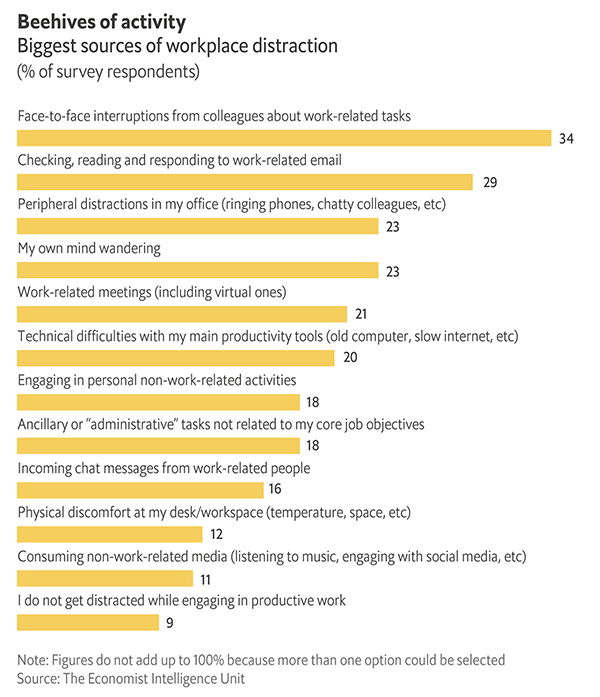Lost Focus is a $1 Trillion Dollar Problem. Here's Why You Need to Reclaim Your Attention.
There are ways to maximize your time while working from home—or anywhere else your tasks need to be done.
Steven Puri
Save time with Sukha
Regaining Focus
The pandemic has forced companies to rethink every aspect of their business. For every Microsoft that allows employees to permanently work from home (WFH), other businesses are reporting serious issues with productivity. A new report conducted by the Dropbox and the Economist Intelligence Unit show that lost focus is costing the economy $1.2 trillion.
Complaints about too many Zoom meetings are rampant, but as the report points out, that’s not the biggest concern. Most knowledge workers only attend one meeting a day. While the actual problems are myriad, an inability to stay on task appears to be the biggest problem faced by employees.
An estimated 581 hours of lost work occur every year—roughly one-third of working time for knowledge workers. In monetary terms, this averages $34,448 per employee. Before lockdowns began, the biggest interruptions were face-to-face contact, followed by digital distractions.
With the former no longer an issue for many workers, email, texts, and notifications are leading the charge, along with the loneliness of being separated from co-workers.
Even in a technological world, humans are still social animals.
Context Switching
Jumping from task to task is a major time killer—and distraction. Seventy percent of respondents check email hourly, with 18 percent claiming they log on every few minutes. Not only does such multi-tasking (or multi-switching) impact your workload, it also negatively affects your memory.
These problems appear to impact general staff more than C-level employees or upper management. While there appears to be no exact reason, top managers are thought to have an invisible “do not disturb” sign around them, which could help them structure their day. Staff members appear to be more easily swayed by distractions.
Still, 70 percent of respondents claim that time management is a personal responsibility, regardless of position. The same amount say they either feel more focused (40 percent) or as focused (30 percent) at home as at their workplace. The problem is that 30 percent, nearly one-third of the workforce, is suffering more while WFH, with 5 percent claiming to be seriously impacted by this model.
One commonality unites respondents: virtually no one misses commuting.
Stressful Times
Managers feel less stress working from home. The opposite is true for employees, with 40 percent stating that their stress levels are up. Miscommunications have also increased—somewhat surprising given that 70 percent of respondents note that they spend more time on email than before. Then again, the written word is a poor replacement for verbal communications.
For much of the tech sector, WFH has long been a reality. Increased levels of loneliness are reported by employees in education and manufacturing, where company culture plays a bigger role. While one-third of respondents cite “lack of connection” as a serious issue in their productivity, only 10 percent blame social media for their inability to focus.
Even with all of these issues, 20 percent of employees were not aware of any mindfulness, stress reduction, or “focus time” available via their companies. As work cultures shift to embrace a WFH model—some will certainly return to the office, though many are just as likely to cut costs on commercial real estate, commuting time, and other WFH perks—the integration of mental health programs is going to be essential. New models demand novel ideas.
Dreaming of the Future
Let’s face it: the WFH model is here to stay. In 2019, Harvard Business School argued that WFH is going to transform companies worldwide. The pandemic merely increased the adoption of this model.
Again, the WFH model is not sustainable for every business. But if some companies were reluctant before, they might have discovered unforeseen benefits from being forced to institute WFH protocols.
Yes, organizational coordination and creative problem-solving are suffering. This could also be due to the newness of the model for a lot of companies. Instituting best practices around workflow could make a big impact.
Limiting email and social media time in specific blocks is also an important technique that leads to more productive work sessions.
Human contact is an obstacle that no amount of Zoom calls can address. There are other perks of WFH, such as cutting down on commute time, which frees up your personal time to connect with others (when we’ve moved beyond quarantine).
It’s important to remember that humans have endured pandemics before. As with every previous lockdown in history, we’ll collectively get through this. Life will look different, but that doesn’t mean all is lost.
In fact, as we’re finding out, with reduced carbon emissions and better air quality thanks to less commuting, there are advantages to the WFH model. Creating your best possible workflow is both a personal and corporate responsibility—one that humans, as creative and ingenious thinkers, are especially suited to implement.

